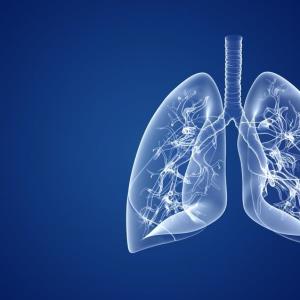Interim results of the Italian, multicentre, open-label, phase IIIb MAURIS trial in “real-world” patients with untreated extensive-stage small-cell lung cancer (ES-SCLC) show similar safety and efficacy to those achieved by atezolizumab plus carboplatin and etoposide in the pivotal, phase I/III IMpower133 trial.
Atezolizumab, an anti–PD-L1 inhibitor, was the first immune checkpoint inhibitor to be approved, in combination with carboplatin and etoposide, for treatment of ES-SCLC. [Drugs 2020;80:1587-1594] This approval was based on primary data from the multinational phase I/III IMpower133 trial in PD-L1–unselected patients with previously untreated ES-SCLC and Eastern Cooperative Oncology Group (ECOG) performance status (PS) of 0–1, who could have treated asymptomatic brain metastases, which showed that addition of atezolizumab to four cycles of carboplatin and etoposide was associated with significantly longer overall survival (OS) and progression-free survival (PFS) vs chemotherapy alone. [Ann Oncol 2020;31:310-317]
MAURIS evaluated the safety and efficacy of atezolizumab plus carboplatin and etoposide in a population with more relaxed selection criteria than the registration trial. Unlike patients included in IMpower133, MAURIS patients could have ECOG PS of 0–2 and untreated asymptomatic brain metastases at baseline.
Between August 2019 and July 2020, 154 patients received atezolizumab 1,200 mg plus carboplatin (5 mg/mL/min) and etoposide (100 mg/m2 on days 1–3 of each cycle) Q3W for 4–6 cycles (according to investigator choice) in the induction phase, of whom 119 entered the maintenance phase, where they received atezolizumab Q3W until disease progression, unacceptable toxicity or clinical deterioration. [Oncologist 2024;29:e690-e698]
At interim analysis, median duration of follow-up was 10.5 months. The median number of cycles was 8.0 for atezolizumab and 6.0 for carboplatin and etoposide. Compared with those who received ≤3 (14.3 percent) or 4 (27.9 percent) cycles of induction, patients who received 5–6 cycles (57.8 percent) were younger, less often male, more often had an ECOG PS of 0, and less frequently had hepatic metastases and previous radiotherapy.
Serious adverse events (SAEs) were reported in 29.9 percent of patients and were related to treatment in 18.2 percent. Incidence of SAEs in the induction phase was lower in patients who received 5–6 cycles vs 4 or ≤3 cycles.
Grade 3/4 treatment-emergent AEs (TEAEs) were reported in 47.4 percent of patients. Neutropenia (9.8 percent) was the most common serious TEAE. None of the other serious TEAEs were reported in >2 percent of patients. Only three serious TEAEs were considered to be related only to atezolizumab (one case of diarrhoea, one of encephalitis, and one of pruritus).
Immune-mediated AEs were reported in 14.9 percent of patients and were serious in 2.6 percent of cases. The most common immune-mediated TEAEs were hypothyroidism, diarrhoea, asthenia, and pruritus. Four cases of serious immune-mediated TEAEs consisted of diarrhoea, decreased platelet count, autoimmune encephalitis, and pruritus.
Median OS in the overall intent-to-treat population was 10.7 months, and was numerically longer in patients who received 5–6 induction vs 4 or ≤3 cycles (13.8, 10.4 and 2.7 months, respectively). “The median OS in MAURIS was slightly shorter than in IMpower133 [12.3 months], and 1-year survival rate was lower [41.9 vs 51.7 percent], possibly due to the inclusion of patients with worse prognosis, such as ECOG PS of 2, untreated brain metastases, and a higher proportion of patients with liver metastases,” commented the researchers.
Conversely, the median PFS in MAURIS (5.5 months) was slightly longer than in IMpower133 (5.2 months), and the overall response rate was higher (71.6 vs 60.2 percent). “The MAURIS study provides preliminary evidence that the safety and efficacy of the IMpower133 regimen can be replicated in an ES-SCLC population with more relaxed selection criteria, which are closer to that of ‘real-world’ clinical practice,” concluded the researchers.

